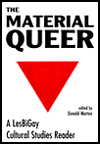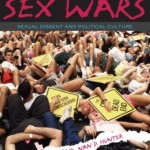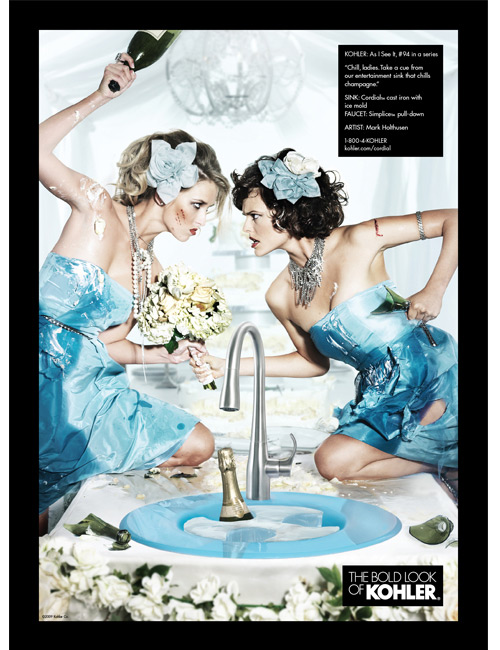Throughout the fall semester (which lasts until December), I will be posting reading notes for my queering theory class here. I will also be posting these entries on the blog for Queering Theory (found here).
For the next three sessions, our class will be discussing “What is queering theory?”. Today, we will begin with part 1 and readings by Cherry Smith, Elizabeth Freeman/Lauren Berlant, and Lisa Duggan (with Nikki Sullivan for some background). I have entitled this entry, “Queer is what queer does?” because all of the articles, in different ways, challenge the idea of queer as something that one is and develop (albeit tentative) definitions of queer and queering through queer practices of resistance and rebellion and queer approaches to politics/theorizing/living. In other words, these readings point to the possibilities for defining what queer is through what queer does.
Incidentally, I am struck by my title here and my choice to write “what queer does” instead of “what queers do”. My title is no accident; it points to the troubling tendency within certain forms of queer theory to privilege “queer/queering” as Practices (of deconstruction, resistance, destabilizing) over situated practices that are done by persons who may or may not identify as queer. Ah ha! Here it is again: the tension between Queer/ing as a concept and queer/ing as specific practices done by actual people. How might it shift our perspective on and our engagement with queering theory if we moved from “queer is what queer does” to “queer is what queers do”?
 “What is This Thing Called Queer?”
“What is This Thing Called Queer?”
by Cherry Smith
After opening her essay with a list of definitions of queer (from a range of sources), Smith outlines a queer agenda and key queer issues as articulated by queer direct action groups like OutRage. This group, formed in London, aims to assert the dignity of lesbians and gay men, fight homophobia, and affirm the rights of sexual freedom. They maintain a tenuous balance between “rejecting assimilation” and “wanting to be recognized” (278). OutRage, along with other groups, like Whores of Babylon, SISSY and PUSSY use extravagant actions that, while fueled by anger, are theatrical, fun and aimed at getting the media’s attention in playful and serious ways–like staging KISS INS or Queer Weddings.
Smith defines queer as “a strategy, an attitude, a reference to other identities and a new self-understanding” (280). As a strategy, queer is about disrupting the system. Queer activists, like those in OutRage, don’t want to work within the system and be accepted by the mainstream, they want to “‘fuck up the mainstream’ as visibly as possible” (279). As an attitude, queer “marks a growing lack of faith in the institutions of the state, in political procedures, in the press, the education system, policing the law” (280). As a new understanding, queer “articulates a radical questioning of social and cultural norms” (280).
Throughout the essay, Smith defines queer in terms of what it does and how organizations use it to resist systems of power that oppress gays/lesbians/queers. Here are some other actions that she mentions: sex-positive reclamation of words, outlandish acronyms, and promotion/visibility of queer sex practices (281).
Hmm…Smith highlights one key queer strategy of the 1990s: outing. Several of the other articles mention outing as well (especially the Duggan essay). Is this an effective strategy? What are the ethics of outing? What are some arguments for and against forcing others into visibility?
CITATION: Smith, Cherry. “What is Thing Thing Called Queer?” The Material Queer. Ed. Donald Morton. Boulder, CO: WestViewPress, 1996. 277-285.
 “From ‘Queer Nationality'”
“From ‘Queer Nationality'”
by Lauren Berlant and Elizabeth Freeman
In this essay on Queer Nation and queer nationality which is also found in the anthology, The Material Queer, Berlant and Freeman describe queer as:
- being deliberately incoherent
- exploiting internal differences
- refusing assimilation while asserting visibility
- employing a wide range of tactics from identity politics, postmodernism, feminism, civil rights movement, peace movement
- fueled with anger and rage
- wanting to value and make visible queer sexual practices as “modes of ordinary identification and pleasure” (307)
- reclaiming/reterritorializing public space (changing oppressive heteronormative spaces into safe queer spaces)
- using surprise attacks and other aggressive actions to expose and “redress the more diffuse and implicit violence of sexual conventionality” (308)
- drawing upon “embarrassment, pleasure, spectacle, longing, and accusation interarticulate to produce a public scandal” (309)
Huh? In discussing the practice of prayer and “queeritual” for Queer Nation, Berlant and Freeman write, “Queer Nation’s emphasis on public language and media, its exploitation of the tension between local embodiment and mass abstraction, forfeits the possibility of such taxonomic clarity” (307). Huh? What do they mean here?
Question: Berlant and Freeman write: “Being queer is not about a right to privacy: it is about the freedom to be public…” (306). What do queer theorists (and/or queers who do theory) think about public, private, visibility, assimilation? Does queer/ing theory allow for safe spaces? What kind of safety is possible when engaging in confrontational direct action? What kind of community/communities are created/fostered through organizations like Queer Nation that are “deliberately unsystematized” (305)?
CITATION: Berlant, Lauren and Elizabeth Freeman. “From ‘Queer Nationality’.” The Material Queer. Ed. Donald Morton. Boulder, CO: WestViewPress, 1996. 305-309.
 “Making it Perfectly Queer”
“Making it Perfectly Queer”
by Lisa Duggan
In the opening paragraph, Duggan suggests that queer/ing theory and queer organizations (like Queer Nation) “carry with them the promise of new meanings, new ways of thinking and acting politically” (149). She devotes much of the essay to discussing how that “promise is sometimes realized, sometimes not” (149). Her essay is organized around several scenes of gay/lesbian/queer activism and resistance.
The first scene takes place in New York City at the St. Patrick’s Day Parade and is centered on Mayor David Dinkins and his experiences of and reactions to anti-gay violence as he marches with the Irish Gay and Lesbian Organization. In speaking out against this violence, Dinkins appeals to liberalism and tolerance and invokes the civil rights movement. Duggan argues that such appeals, while standing out as “movements of highly visible achievement” for gays and lesbians, are still limited in their success. The inclusion that they provide is only “negotiated on humiliating terms” and does not guarantee public civility (152).
Duggan contrasts this scene of liberalism with a second scene of militant nationalism. Taking place in New York City in spring 1991, this second scene involves posters of celebrities–most notably Jodie Foster–being outed as “absolutely Queer.” This approach, coming from “new gay militants” in ACT UP and Queer Nation, rejects tolerance and assimilation in favor of publicity, self-assertion, confrontation and direct action (153). Duggan argues that these militant tactics draw upon the ideology of nationalism and the idea of a nation of gays who share a common experience, are easily identifiable, and are linked under a clear and united definition of gay/lesbian/queer. She writes:
Outers present their version of gay nationalism as radical but, like other nationalisms, its political implications are complex and often actually reactionary. These new nationalists define the nation and its interests as unitary; they suppress internal difference and political conflict (154).
In critiquing this position, Duggan also writes:
any gay politics based on the primacy of sexual identity defined as unitary and ‘essential,’ residing clearly, intelligibly and unalterable in the body or psyche, and fixing desire in a gendered direction, ultimately represents the view from the subject position ‘twentieth-century, Western, white, gay male’ (155).
Question: What does she mean here? According to Duggan, what are the dangers of outing?
The third scene takes place at a writer’s conference in San Francisco, again in 1991, and offers a challenge to the tension between academics and activists as they struggle over the question of essentialism-versus-social-construction (156). Here is how Duggan describes the tension:
In its most cliched formulations, this controversy is presented in one of two ways: valiant and dedicated activists working to get civil rights for gay and lesbian people are being undermined by a bunch of obscure, arcane, jargon-ridden academics bent on ‘deconstructing’ the gay community before it even comes into full visibility; or theoretically informed writers at the cutting edge of the political horizon are being bashed by anti-intellectual activists who cling naively to the discursive strategies of their oppressors (156).
Question: What is at stake with this debate? Is this the only way to think about social construction versus essentialism?
Duggan argues that the writers conference, which brought together a wide range of scholars, artists and activists constructed a queer “oxymoronic community of difference” (156)–a community that was not based on shared experiences or identities but on a similar difference from (and resistance to) the norm (157). This new vision of community challenges seemingly entrenched (within feminist and gay/lesbian politics) ideas about how community is created, the relationship between the academy and activism, and the necessity of invoking liberal and/or nationalist strategies of resistance.
Questions: What does a community like this look like? How does it function? What purposes does it serve? How does this third scene relate to the other two? What is Duggan’s purpose in offering it–is it a viable/promising alternative to liberalism and nationalism? Or, something else?
Duggan concludes her essay by reflecting on the challenges that queer theorists face as they attempt to live up to the promise of queering theory:
to engage intellectually with the political project in the best sense of ‘theory,’ while avoiding jargon and obscurantism in the worst sense of ‘academic’ (161).
to open up the possibilities for coalition across barriers of class, race, and gender, and to somehow satisfy the paradoxical necessity of recognizing differences, while producing (provisional) unity: Can we avoid the dead end of various nationalisms and separatisms, without producing a bankrupt universalism (162)?
CITATION: Duggan, Lisa. “Making it Perfectly Queer.” Sex Wars: Sexual Dissent and Political Culture. Eds. Lisa Duggan and Nan Hunter. New York: Routledge, 2006. 149-163.



